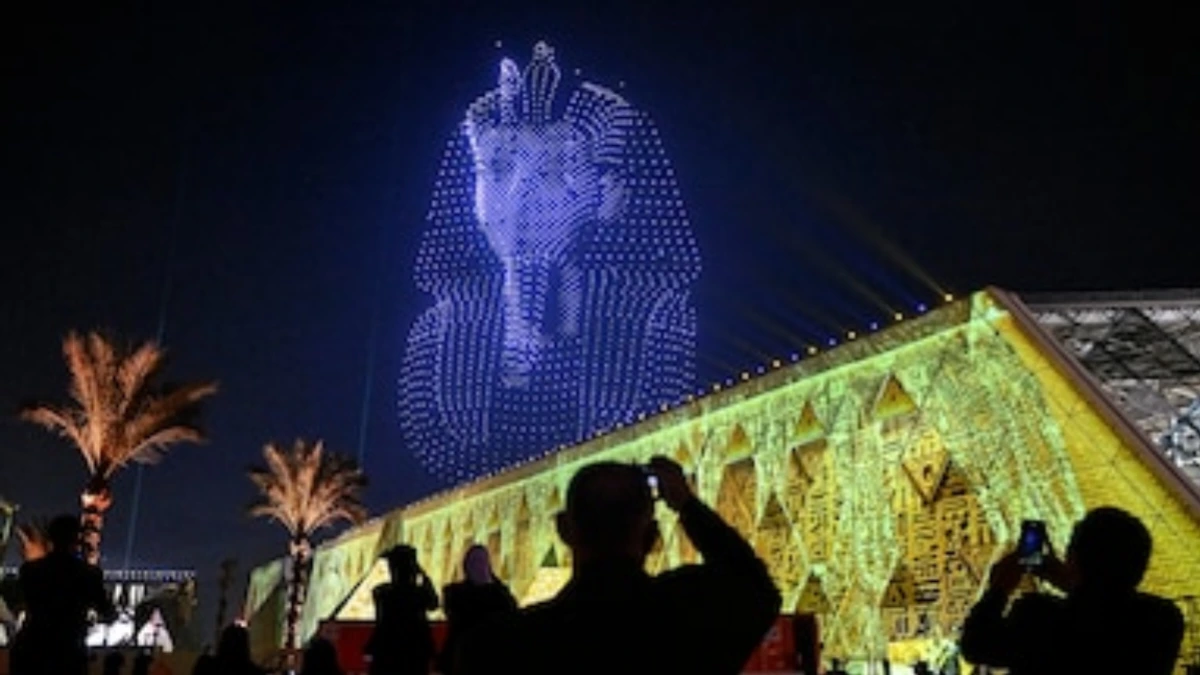CAIRO — After more than twenty years of planning, construction and delays, Egypt officially opened the Grand Egyptian Museum in a glittering ceremony near the Giza Pyramids, marking the completion of one of the most ambitious cultural projects in the nation’s modern history.
The lavish event, attended by European and Arab royals, presidents and dignitaries from around eighty countries, celebrated what officials hailed as the world’s largest museum devoted to a single civilization.
Egyptian President Abdel Fattah El-Sisi declared the museum’s full opening “a new chapter in Egypt’s ongoing story,” describing it as a bridge between “our ancient heritage and the aspirations of the future.”
The Grand Egyptian Museum (GEM), located on the Giza Plateau just outside Cairo, has been under development for more than two decades.
First announced in 2002, the project faced repeated setbacks due to funding issues, political instability, the 2011 revolution, and later the COVID-19 pandemic.
Originally slated to open in 2015, the $1 billion facility finally welcomed its first partial visitors last year. Officials said the delay allowed curators to refine the layout and ensure the safe relocation of fragile antiquities, including thousands of objects from the collection of Tutankhamun.
The museum spans nearly 24,000 square meters of permanent exhibition space roughly equivalent to four football fields and houses more than 57,000 artifacts tracing Egypt’s history from the pre dynastic era to the Greco Roman period.
It also features the Middle East’s largest conservation center and an educational wing for children. Archaeologists and cultural experts hailed the Grand Egyptian Museum as a milestone in heritage preservation and tourism development.
“This project represents Egypt’s renewed confidence in its cultural power,” said Dr. Laila Hassan, an Egyptologist at the University of Alexandria.
“The scale of the museum allows us to display artifacts that have never been exhibited before, in conditions that meet the highest international standards.” Foreign experts involved in the project emphasized its global significance.
“The Grand Egyptian Museum is not only a national achievement it’s a world class institution that places ancient Egypt within a modern narrative of innovation and diplomacy,” said Jean Luc Martin, a French architect who contributed to the museum’s design team.
Analysts also noted the opening’s timing amid regional tensions. “Egypt’s government is using the museum as both a symbol of stability and a soft power tool,” said Amira Fakhry, a Middle East cultural policy analyst based in London.
It signals to the world that Egypt remains a cultural anchor in a region facing multiple crises. The Grand Egyptian Museum rivals other monumental institutions in scale and ambition.
The Louvre in Paris, for instance, covers roughly 73,000 square meters of exhibition space but spans multiple civilizations. By contrast, GEM’s 24,000 square meter display is devoted solely to Egypt’s ancient heritage.
Tourism authorities expect the museum to attract up to five million visitors annually once fully operational. Before the pandemic, Egypt welcomed over thirteen million tourists each year, with cultural tourism representing nearly 20 percent of its GDP.
Officials hope the new museum will help restore and surpass those figures. The government has also invested heavily in infrastructure surrounding the site, including upgraded highways, hotels and the new Sphinx International Airport, designed to facilitate access for international visitors.
At the inauguration, Cairo residents and foreign guests gathered outside the museum to watch a light and music show that illuminated the desert sky with images of pharaonic gods, drones and fireworks.
“I brought my children here to witness history,” said Fatima Youssef, a local schoolteacher from Giza. “For years, we heard about this museum as a dream. Now it finally feels real.”
Dancers in ornate costumes performed to live orchestral music as screens projected images of the Great Sphinx and ancient temples.
“It’s a proud moment for Egypt and for humanity,” said visitor Ahmed Mahmoud, who traveled from Luxor for the ceremony. “Our ancestors’ stories deserve a home like this.”
Among the international guests were German President Frank Walter Steinmeier, Spanish King Felipe VI, Dutch Prime Minister Dick Schoof, Greek Prime Minister Kyriakos Mitsotakis, and Palestinian President Mahmoud Abbas.
Saudi Arabia’s Minister of Culture, Badr bin Abdullah, and the crown princes of Oman and Bahrain also attended. Officials said the museum’s official public opening will usher in a new era for Egyptian tourism and cultural diplomacy.
The Ministry of Tourism and Antiquities plans to integrate the GEM experience with guided tours of the nearby Pyramids, Sphinx and Grand Avenue of the Sphinxes in Luxor, creating what it called a “pharaonic cultural corridor.”
“The Grand Egyptian Museum will serve as a living archive for future generations,” said museum director Dr. Tarek Tawfik. “It’s not just about preserving the past it’s about inspiring the next wave of scientific and artistic discovery.”
UNESCO praised Egypt’s long term commitment to heritage protection, noting that GEM’s conservation center already collaborates with international teams on restoration projects across the region.
As fireworks faded over the Giza Plateau, President El-Sisi’s words echoed through the ceremony: “We are writing a new chapter of the history of the present and the future in the story of this ancient nation.”
After decades of delay, Egypt’s Grand Museum now stands as both a monument to its ancient civilization and a modern testament to perseverance.
For a country whose identity is intertwined with the sands of history, the Grand Egyptian Museum’s full opening marks a defining moment bridging the grandeur of the past with the promise of tomorrow.

